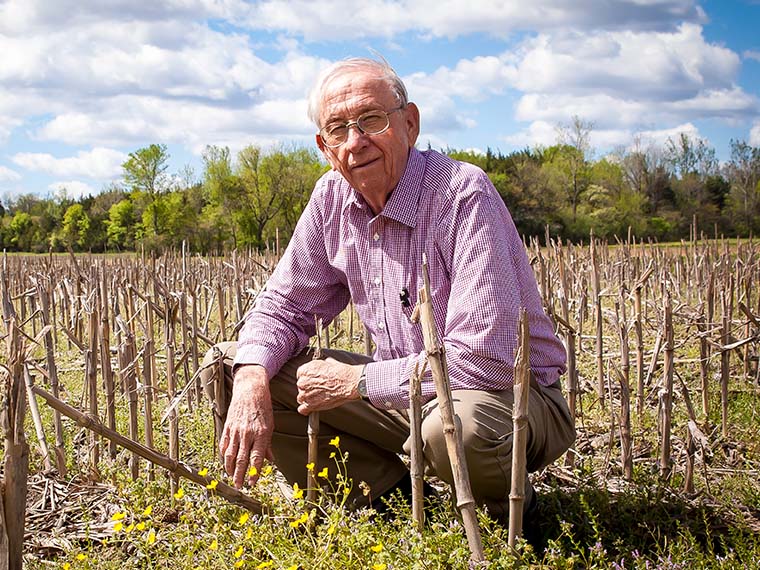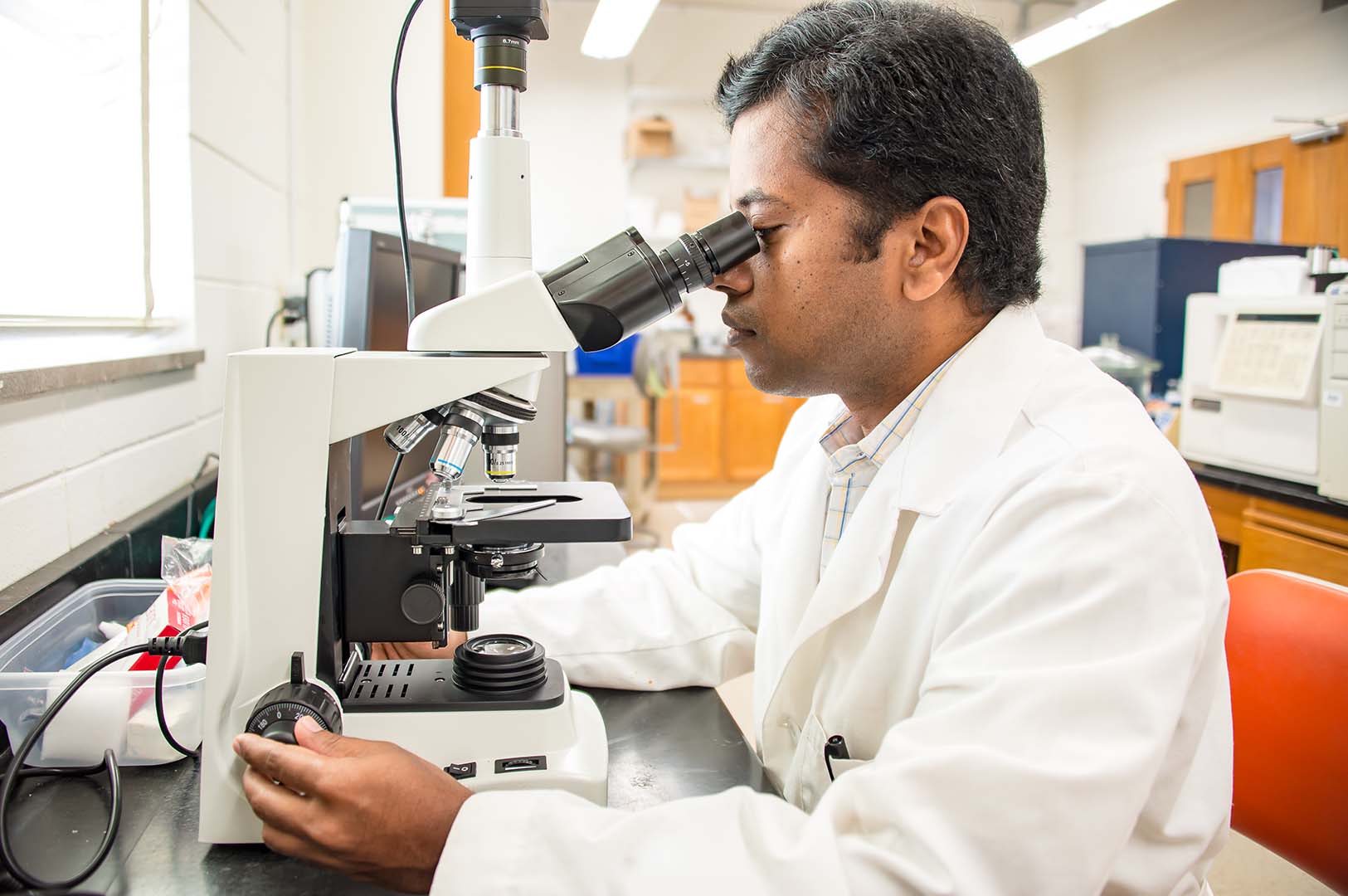The information presented on this page may be dated. It may refer to situations which have changed or people who are no longer affiliated with the university. It is archived as part of Mississippi State University's history.
Some may call him a maverick or a pioneer, but for Dr. Normie Buehring, research professor and agronomist, he was just trying to answer one question: ‘How can we do things better?'
After four decades of research in corn, cotton, and soybeans, Buehring has figured out a thing or two about conservation tillage. And his research is helping north Mississippi farmers get seeds into the ground sooner with fewer equipment passes.
A native of Texas, Buehring was introduced to conservation tillage in the early 1970s, when he began his career as an agronomist at the Northeast Mississippi Branch Experiment Station in Verona, Mississippi. He had heard of the practice but no one was applying it in Mississippi.
His first project was in corn silage production to feed the MAFES dairy herd located on the station. His primary focus was to look at ways to reduce the number of equipment passes across the field required to plant row crops.
"North Mississippi has clay soils, so spring tillage involved several passes to get clods broken up and the fields dried out in preparation for planting," Buehring said. "This often delayed planting or resulted in poor stands with reduced yields."
Buehring remembers well that first field in 1976.
"We got a good stand of corn. It didn't look pretty but it was a nice stand. It looked kind of messy," Buehring noted. "This was a totally new concept in this area of Mississippi. From that point forward, we were doing fall land prep with raised beds on flat ground and then planting corn silage in the stale seed bed. We did that as long as we had the MAFES dairy heifer herd at Verona."
He knew the practice would save producers money with fewer passes across the field. He also knew that the practice would help protect the highly erodible soils in north Mississippi. What he didn't know at the time was how the practice would protect soil health and become adopted throughout the region.
"The concept was that if you could do prep work in the fall, after harvest, all you would have to do in the spring was apply a burndown herbicide and plant," Buehring said. "On our flat ground, we would do our fall land prep on raised beds and then in the spring, take a piece of equipment, called a do-all, to break the clods, and then plant."
Over the years, Buehring has experimented with several crops and rotations in one-pass tillage or no-till operations on highly erodible and bottomland soils, all in a non-irrigated environment. Since corn is more sensitive to surface drainage than soybeans, the longevity of the raised bed height for no tillage on flat ground is a major concern. His most recent work includes a 10-year tillage raised bed system compared to no-till without raised beds with a corn-soybean rotation on a bottomland silty clay soil.
"Our goal has always been to get it down to one pass," Buehring said.
Thus far the study has shown a positive yield response to raised beds 70 percent of the time in corn and 40 percent of the time in soybeans.
Buehring noted that no-till production is possible on old beds as long as the spring bed heights are about four inches or greater. Beds may need to be reshaped every three or four years on clay soils and every other year on silt loam soils.
The economics of the operation are also promising.
"The in-row-subsoiler-bed-roller (TerraTill®), one pass implement, applied every other year, yielded better gross returns above tillage costs in corn and soybean compared to several other tillage methods including continuous no-till, bed-roller applied annually or every three or five years, and TerraTill applied every year or every three to four years," Buehring said.
On sloped land, no-till is the best option because of the highly-erodible soils. Buehring's research has demonstrated that the corn/soybean rotation is a good one for these soil types.
In the early years, Buehring modified many of the implements for his conservation tillage research program. The practice was new and equipment manufacturers hadn't developed tools for one-till or no-till operations.
In the early 90s, Buehring was invited to speak to the Equipment Manufacturers Institute about future tillage equipment needs.
"I challenged them to develop implements for one pass tillage operations," Buehring said. "In the 1970s, we didn't have the equipment that we have today, implements to move the old crop residue away from the planter path, consistent control of the planter's seed depth placement, and planters that consistently close the seed slit. It wasn't until the early 2000s that manufacturers began to build the equipment to do this. Now, it's easier for farmers to plant in a no-till or reduced-till environment and be successful."
Most producers following the conservation tillage program burn-down with a herbicide in the spring prior to planting and then plant with a no-till planter. Some of the producers in the area are burning down in the spring and then running a one pass tillage operation in front of the planter, which has worked well for soybean and corn.
"As a result of the research on the station's bottomland soils, we are using the TerraTill every other year in a corn-soybean rotation," Buehring said. "We plant corn the year following the fall TerraTill operation and then the next year we do no-till soybeans. On our highly erodible soils we use no-till production in an every other year corn-soybean rotation."
As for soil health, new analysis reveals that conservation tillage maintains higher soil biodiversity than other tillage systems.
Dr. Shankar Shanmugam, a post-doctoral research associate in the Department of Plant and Soil Sciences, performed DNA analysis on the soil, a technique not available when Buehring first began the research. Shanmugam conducts research with Dr. William Kingery in the department's Soil Microbiology Lab.
The process began with soil samples from soybean plots planted in corn residues from four different tillage practices. Conservation tillage consisted of no-till and an in-row-subsoiler-bed-roller, one-pass implement (TerraTill). Conventional tillage systems included bed-roller and disk plus TerraTill.
Shanmugam extracted the microbial DNA from the soil and then sequenced the DNA. Once sequenced, the DNA was compared to an existing database to identify bacteria in the soil. About 100,000 sequences were obtained from each soil sample. After filtering, 20,000 to 25,000 bacteria were positively identified at the genus level.
"We found greater diversity of bacteria or soil microbiome in the conservation tillage soils than the conventional tillage soils," Shanmugan said. "Based on three years of sampling, there is a trend of greater diversity in these soils, indicating that conservation tillage is better for the soil."
Shanmugam looked at physical, chemical, and biological changes in the soil. His study found that there were no significant changes in the physical and chemical properties of the soil; however, the biological changes were significant.
"Soil contains bacteria and fungi. In agricultural ecosystems, bacteria are better soil health indicators than fungi and are sensitive to management practices," he said. "Greater diversity of bacteria makes the soil healthier."
Shanmugam went on to explain the greater diversity in the soil helps to conserve carbon throughout the growing season.
"In a conventional tillage system, the organic carbon is available more quickly for crops but also depletes more rapidly," he said. "In conservation tillage, organic carbon can last throughout the growing season thus requiring fewer chemical inputs."
Clearly, conservation tillage creates stable soil environments which favor diverse microbial communities and slower nutrient turnover, Shanmugam added.
And while the research continues at the Northeast Mississippi Branch Experiment Station, Buehring's studies have clearly answered the question of ‘How can we do things better?'
In North Mississippi, conservation tillage saves producers fuel and labor costs, allowing them to plant earlier and improve yield potential while also diminishing soil erosion and contributing to soil health.


